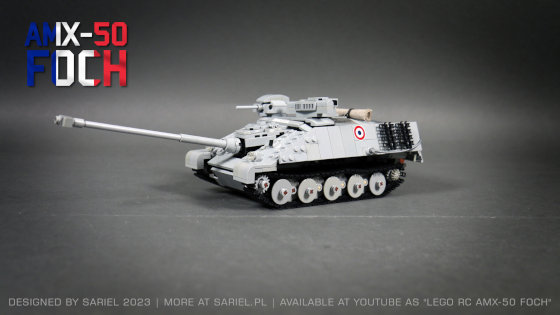AMX-50 Foch
Model of a French tank destroyer. Features drive, steering, suspension and remotely controlled traverse & elevation of main gun and the turret gun.
Datasheet:
Completion date: 20/11/2023
Power: electric (Power Functions)
Remote control: SBrick
Dimensions: length 46 studs / width 14 studs / height 11 studs
Weight: 0.736 kg
Suspension: oscillating bogies
Propulsion: 2 x PF M motor geared 2.33:1
Motors: 4 x PF M, 1 x PF Servo, 1 x Micromotor
The AMX-50 project was launched in France promptly after WW2 with the goal of making France competitive tanks manufacturer against US and British vehicles. The program involved four separate tanks, all designated AMX-50, as well as a tank destroyer project intended to provide supporting fire for the tanks. In the end, none of these vehicles made it to production as US Army provided allied countries with free surplus M47 tanks after these were deemed inadequate for the Korean war and started being phased out by the M48 tank. Still, the AMX-50 tank destroyer was an interesting project, largely inspired by the German Jagdpanther, to the point where some design stages involved help from German tank engineers. It was designed with emphasis on firepower and mobility. The destroyer’s distinguishing features included a commander’s cupola with a massive rangefinder and having the main gun mounted in a narrow protrusion on the glacis plate. I thought it would be an interesting challenge to fit a gun with a decent range of motion inside such a protrusion.
The model ended up being near the 1/30 scale and it was a rather extreme exercise in squeezing things inside. In fact, the chassis pretty much ends on top of the tracks and there are only a few bricks above, the rest is all motors and wires. The video below shows the inside view. As a result, the model was quite fragile, but still robust enough to drive along forest paths without falling apart. It housed a total of 6 motors, the 8878 battery and one SBrick. Two PF M motors provided drive and steering while a PF Servo motor was laid flat on the bottom of the chassis and controlled the main gun’s traverse. The PF Servo is a large motor but it didn’t require any gear reduction for that function, so it ended up not needing that much space after all. Another PF M motor controlled the main gun’s elevation while one more PF M and a Micromotor were slaved to the main gun’s traverse & elevation motors and controlled the turret. In order to fit the turret mechanism I had to place the Micromotor right above a track, and it partially showed from under the side armor. The turret was traversed by a PF M motor driving a worm gear meshed with a red t8 gear on an axle – this gear has ability to slide along axles. I’ve used that to control the turret elevation by having the Micromotor push the axle going through the 8t gear up or letting it slide down under its own weight. That didn’t always work as that weight was minuscule and ideally a rubber band should have been used, but I wasn’t able to find enough room for it.
The suspension relied on simple oscillating bogies, but because there was an odd number of road wheels, I had the six rear wheels mounted on three bogies, two wheels each, and the three front wheels mounted on a single bogie with the wheel #2 being its axis and thus effectively not suspended. I have initially used thin beams for the suspension, but they proved so fragile and wobbly that I eventually added extra space between the tracks and the chassis and used regular beams instead.
I was unable to find what color scheme would be historically accurate, as the few remaining photos of the destroyer are exclusively black & white. The World of Tanks game shows all French armored vehicles in a color that can be described as deep sea green, which has no direct LEGO equivalent. I’ve felt that the closest LEGO color is dark turquoise and I’ve started building the body with it, but this is a pretty rare LEGO color and after reviewing the availability and prices of dark turquoise LEGO pieces, I’ve decided to go with simple light gray.
The model definitely didn’t look quite right, especially because the side armor’s angle and length weren’t quite correct. This was in part because the angle of the glacis plate doesn’t match any LEGO wedge pieces, so if I wanted to put the side plates under the glacis plate, this would result in some gaps. Instead, I put the side plates over the glacis plate’s sides. The turret elevation mechanism was notoriously unreliable, and the turret itself was oversized because otherwise I wouldn’t be able to fit the mechanisms in it.
It remains debatable whether there’s really a point in squeezing so many mechanism inside such a small model, because it has definitely impacted its look in a negative way, but it was certainly a good exercise for me.









